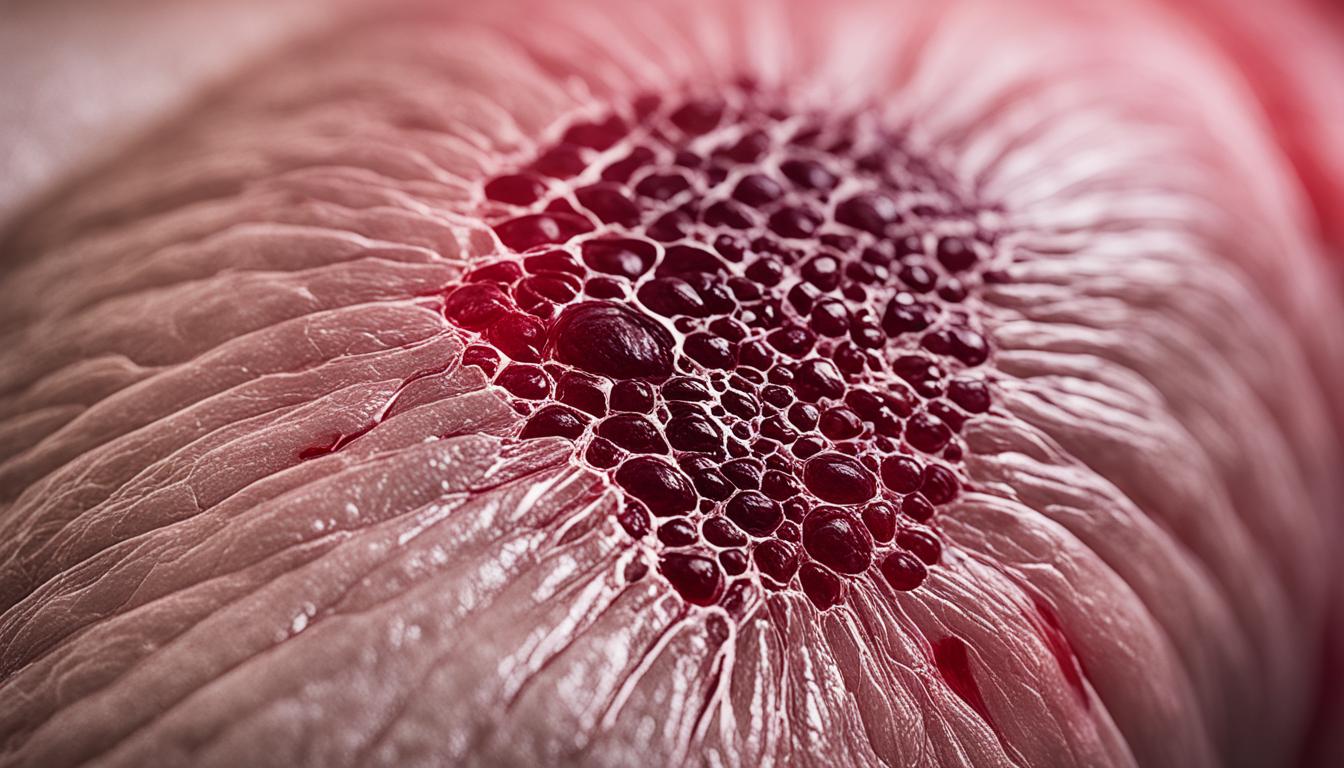Epidermoid cysts, or sebaceous cysts, are common skin issues. They usually grow on the face, head, neck, back, and private area. These cysts are slow-growing and harmless. If they cause cosmetic issues or get infected, surgery is an option.
Symptoms of epidermoid cysts include round bumps under the skin. They can get as big as 5cm. A small black spot may be at the center. Infected cysts can get red, swollen, and sore. Infections can lead to more serious problems. Treatment includes cutting out the cyst, taking antibiotics, and using painkillers.
Key Takeaways:
- Epidermoid cysts are common skin issues. They are usually harmless and can be removed through surgery if needed.
- They show up as solid-filled round bumps. When infected, they can get red, swollen, and painful.
- Complications may include more severe infections and discomfort in private areas.
- Doctors treat these by removing them, using antibiotics, and giving painkillers.
- Further research is being done on using stem cells to treat these cysts.
Causes and Risk Factors of Epidermoid Cysts
Epidermoid cysts, sometimes called sebaceous cysts, form when skin cells move under the skin and grow. They happen in areas with big oil glands, like the face.
Several things can lead to epidermoid cysts. This includes puberty, having a history of acne, and too much sun without protection. Cuts or skin wounds can make it easier for a cyst to start. Also, men tend to get these more than women.
Common Causes and Risk Factors for Epidermoid Cysts:
- Puberty
- History of acne
- Frequent unprotected sun exposure
- Skin lesions
- Male gender
Epidermoid cysts are not common before puberty. If someone had acne, or was in the sun a lot without protection, they have a bigger chance of getting them.
| Cause | Risk Factor |
|---|---|
| Puberty | Increased hormonal activity |
| History of acne | Higher likelihood of cyst formation |
| Frequent unprotected sun exposure | Greater risk of skin damage and lesions |
| Skin lesions | Provides a site for cyst development |
| Male gender | More susceptible to epidermoid cysts |
Diagnosis and Treatment of Epidermoid Cysts
Doctors often can tell if you have an epidermoid cyst by looking at it and asking about your health. They might also use tools like ultrasound or MRI to check the cyst further. This helps see how big it is and what’s inside.
The best way to get rid of an epidermoid cyst is by a complete cut out, known as surgical excision. This surgery removes the entire cyst and its wall to stop it from coming back. It’s usually a quick, simple process that you can have done without staying in a hospital.
But, if the cyst is big or in a tricky spot, you might need to see a special doctor. This could be a dermatologist who knows a lot about skin or a plastic surgeon who can handle more complex cases.
If your cyst is infected and causing you pain, your doctor might first give you antibiotics to clear up the infection. They might also suggest nonsteroidal anti-inflammatory drugs (NSAIDs) to help with the pain and swelling. This is done before thinking about surgery.
Surgical Excision of Epidermoid Cysts
Surgical removal is key to treating epidermoid cysts. It’s a proven method that works well.
| Procedure | Benefits |
|---|---|
| Complete removal of the cyst | Prevents recurrence |
| Preservation of healthy tissue | Minimal scarring |
| Outpatient procedure | Quick recovery |
During surgery, the doctor takes out the cyst and its wall very carefully. This ensures that all the stuff inside, even the solid parts, get removed. By doing this, the chance of the cyst coming back is much lower.
Antibiotics for Infected Epidermoid Cysts
For an infected epidermoid cyst, you’ll need antibiotics. These medicines fight the infection and keep it from getting worse. The kind of antibiotic you get depends on how severe the infection is and your medical history.
- For an average infection, you’ll likely take antibiotics by mouth for a set time given by your doctor.
- If the infection is serious or has formed an abscess, you might need strong antibiotics put into a vein at the hospital.
- To help with the pain and swelling, the doctor could also recommend NSAIDs, which are anti-inflammatory drugs.
It’s crucial to finish all the antibiotics your doctor tells you to take. This makes sure the infection goes away completely.
Stem Cell Therapy for Epidermoid Cysts
Stem cell therapy is changing how some diseases are treated, including epidermoid cysts. It uses stem cells to help the body heal itself. This approach aims to speed up healing and grow new tissue.
This method can help with epidermoid cysts by reducing swelling and growing new skin. Stem cells are put into the area that needs healing. Then, the body starts a healing process, making recovery better for patients.
Thailand is a top choice for this therapy. The country has top-notch clinics and skilled doctors. For those thinking about stem cell therapy in Thailand, it means access to the best care. This can lead to a better recovery and a higher quality of life.

